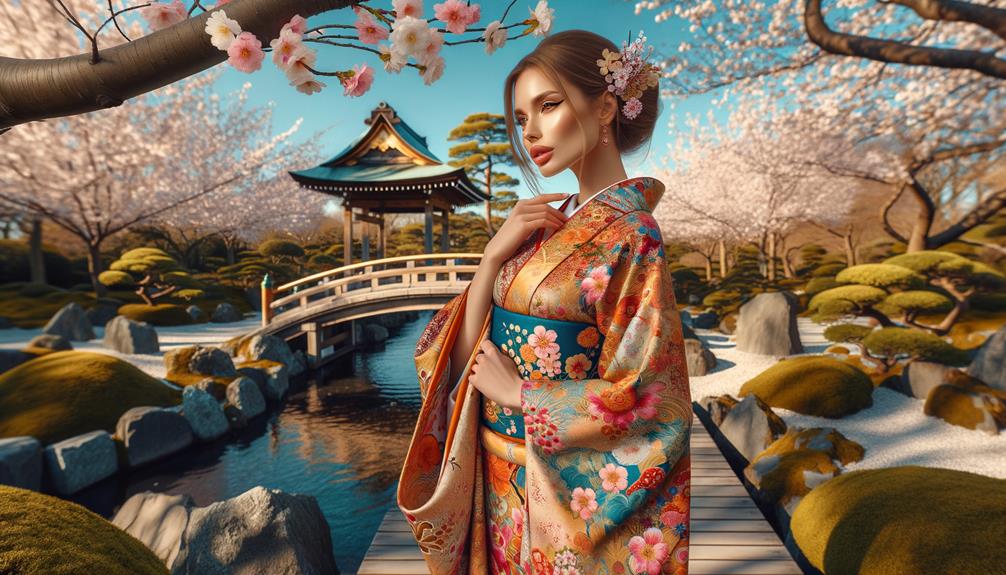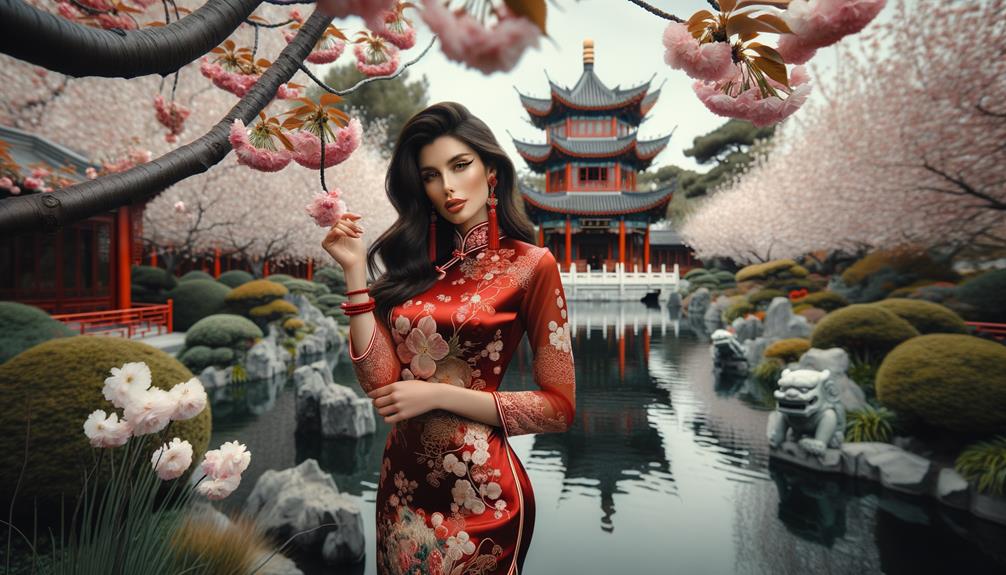As I reflect on the traditional Bavarian dirndl, its rich history unfolds before me. Born out of practicality as sturdy workwear for Alpine peasants in the 16th century, it has evolved into a symbol of Bavarian pride. The dirndl comprises a structured bodice, an intricately detailed blouse, a flowing skirt, and an apron that adds a splash of color and personality. Each element, from lace accents to unique fabrics, speaks to a timeless tradition and modern elegance. Even the way one ties the apron bow signals marital status. To truly appreciate its legacy and craftsmanship, the journey continues ahead.
What Is a Dirndl?
A Dirndl is a traditional feminine garment from the German-speaking Alpine regions, known for its snug bodice, high-waisted skirt, and classic apron. When I think about the traditional Dirndl, I imagine its vivid designs, each reflecting a unique blend of regional customs and traditions.
The tight-fitting bodice accentuates the waist, creating an elegant silhouette that’s both timeless and enchanting. The high-waisted skirt, often full and flowing, adds a sense of grace and movement, making it perfect for festive occasions like Oktoberfest.
In my experience, the Dirndl is more than just a dress; it’s an ensemble. It starts with a crisp blouse, usually white, that peeks out from beneath the bodice. The apron, tied meticulously, not only complements the dress but also carries its own cultural significance. It’s fascinating how a traditional Dirndl can be accessorized with intricate, traditional German jewelry, enhancing its charm and authenticity. Each element, from the snug fit of the bodice to the flow of the skirt, speaks to a rich heritage while allowing for personal expression. This blend of tradition and individuality makes the Dirndl a truly captivating piece of clothing.
History of the Dirndl
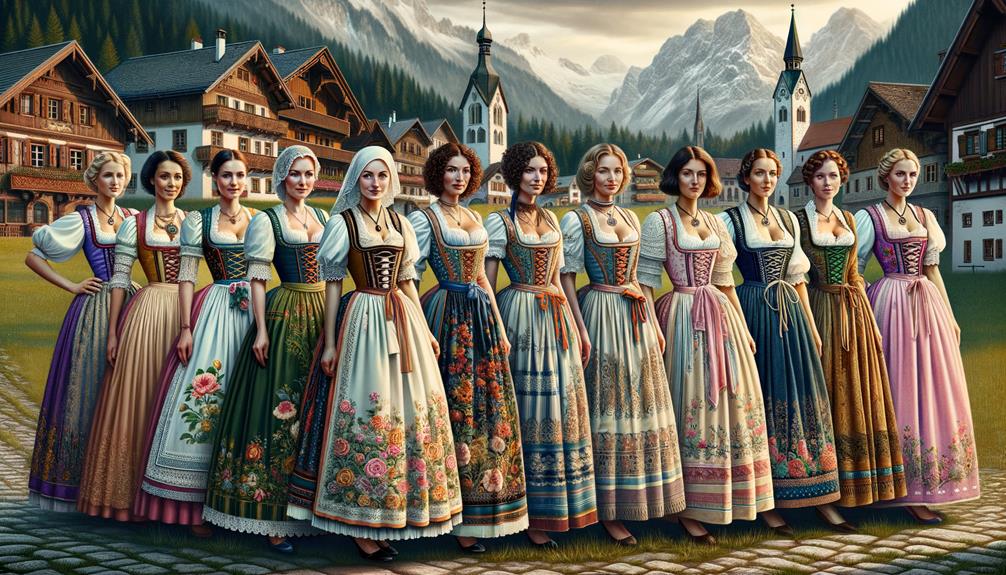
When I think about the history of the Dirndl, I imagine its humble beginnings as practical workwear for Alpine peasants in the 16th century. It’s fascinating how, by the late 19th century, it transformed into a fashionable ensemble for the upper classes. This evolution highlights the cultural significance of the Dirndl, showcasing the rich tapestry of regional traditions and customs that define it.
Origins and Evolution
The Dirndl, a garment with a rich history, originated as humble workwear for Alpine peasants between the 16th and 18th centuries. Initially designed for practicality, the German Dirndl was a maids’ costume that provided support with its tight bodice, allowed ease of movement with its full skirt, and offered protection with its apron.
The transformation of the Dirndl is a fascinating story. By the late 19th century, what started as simple workwear evolved into a fashionable three-piece outfit. The upper classes adopted and adapted the Dirndl, incorporating luxurious fabrics and intricate designs. Despite these changes, the core elements – bodice, skirt, and apron – remained consistent, a testament to its enduring design.
The variations in color, cut, and patterns of the Dirndl are not just aesthetic choices; they reflect regional customs and traditions from German-speaking Alpine regions. The Dirndl’s evolution is a blend of functionality and cultural expression, evolving while maintaining its essence. Today, it stands as a symbol of heritage, transcending its origins to become a cherished attire for celebrations like Oktoberfest. The Dirndl’s journey from peasant practicality to cultural icon is remarkable.
Cultural Significance
In exploring the cultural significance of the Dirndl, it’s fascinating to see how this traditional dress brings together centuries of history, regional pride, and communal identity. Originating as humble workwear for Alpine peasants between the 16th and 18th centuries, the Dirndl underwent a dramatic transformation by the late 19th century when the upper classes adopted its charm. Each region’s unique customs and traditions are preserved through distinct variations in color, cut, and patterns, making every Dirndl a testament to its roots.
The modern Dirndl, often showcased during Oktoberfest, has evolved into a stylish three-piece ensemble. Its defining features – a tight-fitting bodice, a full skirt, and an apron – remain consistent, blending elegance with functionality. This timeless design not only honors its peasant origins but also offers a versatile and inclusive garment for people of all backgrounds to wear during celebrations and events.
As I reflect on the Dirndl’s journey from a utilitarian garment to a cultural icon, I see it as more than just attire. It’s a living piece of history, a symbol of regional pride, and a vibrant element of communal festivities like Oktoberfest.
Components of a Dirndl
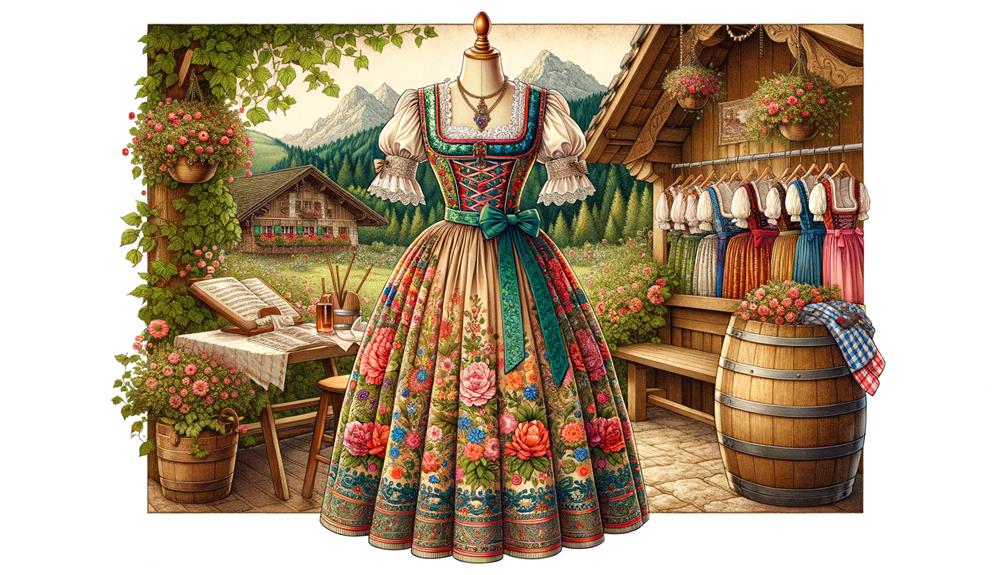
When I think about the components of a Dirndl, I envision the snug-fitting bodice and crisp white blouse that frame the upper body. The full, high-waisted skirt and vibrant apron create a striking silhouette, each piece contributing to its timeless elegance. Let’s delve into how these elements, along with accessories and footwear, come together to form this iconic Bavarian attire.
Bodice and Blouse
As I examined the intricate lace on the puffy sleeves of the Dirndl blouse, I realized how much these delicate details contribute to its timeless elegance. The blouse, often adorned with embroidery or lace, pairs flawlessly with the bodice to create a silhouette that’s both classic and feminine. The bodice, traditionally tight-fitting, is designed to accentuate the waist, providing a flattering shape that celebrates the wearer’s figure. This combination of the bodice and blouse is a tribute to meticulous craftsmanship, blending traditional aesthetics with contemporary flair.
Different fabrics like cotton, polyester, or blends are used in crafting these components, each adding a unique texture and feel. The bodice can be simple or ornate, depending on the occasion, but it consistently serves as the foundation of the Dirndl’s look. The attention to detail in the blouse, with its puffy sleeves and lace accents, complements the structured bodice perfectly. Together, they define the Dirndl’s overall style and elegance.
In an era that values innovation, the Dirndl’s bodice and blouse remind us that tradition and modernity can coexist beautifully, creating a garment that’s both historical and strikingly relevant.
Skirt and Apron
The Dirndl’s skirt, with its full, gathered fabric, creates a timeless silhouette that falls below the knee or even to the ankle. I find myself captivated by the way it moves, flowing elegantly with each step. This classic look is rooted in a rich cultural heritage, evident in every fold and pleat.
The Dirndl apron is an integral part of the ensemble, offering both functionality and flair. Made from materials like cotton or silk, these aprons often feature intricate patterns or delicate embroidery, adding a personal touch. I appreciate how the apron’s design can vary, reflecting regional influences and individual creativity.
The way the Dirndl apron is tied – whether in the front or back – also holds significance, sometimes indicating the wearer’s marital status. This subtle detail adds depth to the attire. Together, the skirt and apron create a harmonious blend, allowing for endless customization. This versatility affirms that each Dirndl is a unique expression of identity and tradition, resonating with contemporary sensibilities while honoring its historical roots.
Accessories and Footwear
Accessories and footwear bring a Dirndl to life, transforming it from a simple dress into a vibrant expression of Bavarian heritage. When I put on my Dirndl, it’s the details that make it truly stand out. The aprons, often adorned with floral, checked, or embroidered designs, add a pop of color and personality to the outfit. Each apron tells a unique story, blending tradition with a touch of modern flair.
Bodices and blouses are essential components of the Dirndl, each crafted to complement the dress. The bodice provides a snug, supportive fit, shaping the silhouette, while the blouse adds a delicate touch of elegance. Apron pins and traditional jewelry, such as Edelweiss pendants or intricate brooches, add an authentic touch to the overall look. These pieces aren’t just accessories; they’re a connection to a rich cultural heritage.
Footwear plays a crucial role in completing the Dirndl ensemble. Traditional Haferlschuhe, with their sturdy leather design, anchor the outfit with a sense of rugged authenticity. For a lighter touch, ballerina flats offer comfort without sacrificing style. Both choices reflect a balance of practicality and grace, ensuring that each step taken in a Dirndl is steeped in tradition and innovation.
How to Wear a Dirndl
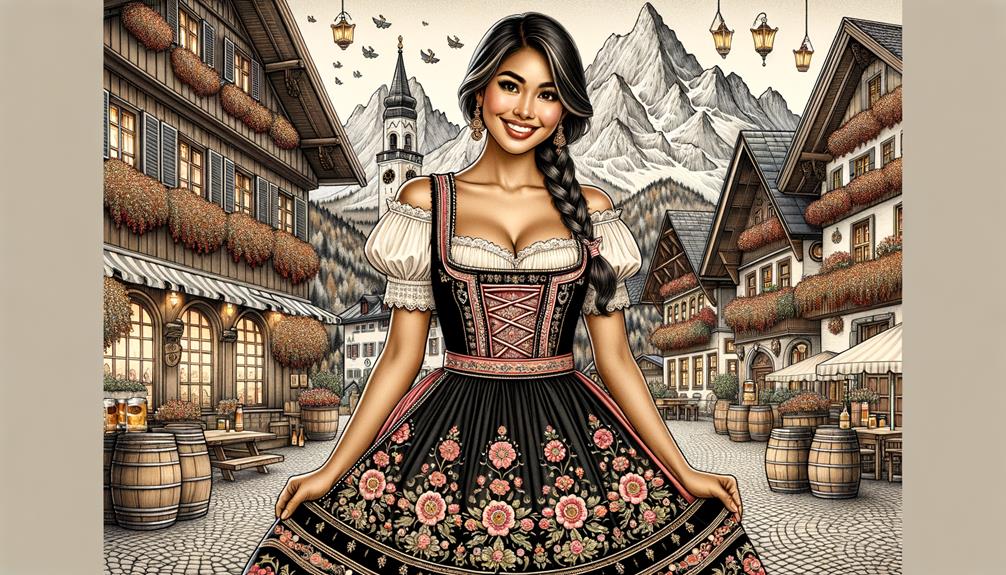
Wearing a dirndl is an art that requires attention to detail and a sense of traditional Bavarian charm. It all starts with a crisp white blouse that sets the tone for the entire outfit. I opt for a snug cotton or lace blouse that fits perfectly, creating a classic, elegant look.
Next, I lace up the bodice tightly to accentuate my waist and create a flattering silhouette. The dirndl’s bodice is more than just a pretty face – it’s a testament to traditional Bavarian craftsmanship. Underneath the skirt, I add a petticoat to give it volume and ensure the dirndl maintains its iconic shape.
To complete the look, I accessorize with traditional German jewelry, such as a choker necklace or delicate earrings. These add a touch of elegance and authenticity to the overall outfit. Footwear is also crucial – I choose comfortable flats or stylish ankle boots, paired with matching stockings to keep the look polished and cohesive.
Here’s a quick reference guide to help you get it right:
| Step | Description | Importance |
|---|---|---|
| Blouse | Crisp white cotton or lace | Sets the traditional Bavarian look |
| Bodice | Lace tightly to accentuate waist | Ensures flattering silhouette |
| Petticoat | Adds volume underneath the skirt | Maintains classic silhouette |
Tying the Dirndl Bow
Understanding the symbolism and proper placement of the dirndl bow can elevate your outfit from charming to truly enchanting. The bow is more than just an accessory; it holds significance within traditional German attire. If you tie the bow on the right side, it signals that you’re taken, while placing it on the left side indicates you’re single and perhaps open to conversation.
These small, deliberate choices add a layer of personal expression to my ensemble. Regional customs may vary, but the core symbolism remains potent. Beyond the bow’s placement, its length can speak volumes. A longer bow might suggest a playful or flirtatious mood, adding a touch of whimsy to your look.
Tying the bow with precision is crucial to maintain a polished and authentic appearance. The act of tying it correctly feels like a ritual, a final touch that transforms the dirndl from mere clothing into a statement of elegance and tradition. Each detail, from placement to length, contributes to a look that harmonizes with both history and personal sentiment.
Care and Cleaning Tips
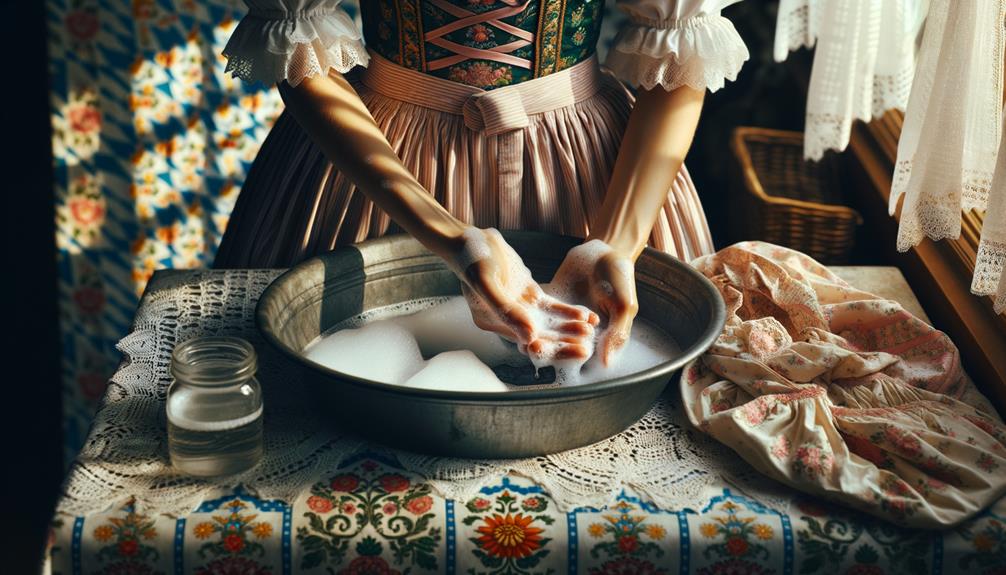
Caring for my dirndl dress requires a meticulous approach to ensure it remains a timeless piece in my wardrobe. Each detail, from the vibrant Bavarian patterns to the delicate lace trims, demands thoughtful attention. I avoid machine washing altogether, opting instead for professional dry cleaning to guarantee the fabric retains its integrity and the colors stay as vivid as the day I first wore it.
I prefer steam ironing to keep the dirndl crisp and immaculate. The gentle steam smooths out wrinkles without compromising the fabric’s robustness. I take special care around the intricate details, allowing the steam to refresh the dress without direct contact.
Frequently Asked Questions
What Is a Traditional Bavarian Dress Called?
A traditional Bavarian dress is called a Dirndl. This charming outfit has a rich history, blending elegance with a bodice, blouse, skirt, and apron, making it a timeless symbol of culture and style.
What Is a Bavarian Dirndl?
I see a Bavarian Dirndl as a perfect blend of tradition and style. This classic Alpine outfit, consisting of a blouse, bodice, skirt, and apron, has evolved from humble peasant workwear to a stylish staple at celebrations.
What Is the National Dress of Bavaria?
Bavaria’s national dress, the Dirndl, is a stunning representation of the region’s rich cultural heritage. When I wear it, I feel a strong connection to the past, yet it also feels modern and stylish – perfect for celebrating Bavarian traditions with flair.
Let me know if this meets your requirements!
What Is the Etiquette for the Dirndl?
When I wear a Dirndl, I know the apron bow’s placement matters: if it’s on the left, I’m single, on the right, I’m taken, and in the center, I’m either widowed or working as a waitress. A skirt that falls just above the knee and a fitted bodice complete the traditional look.



